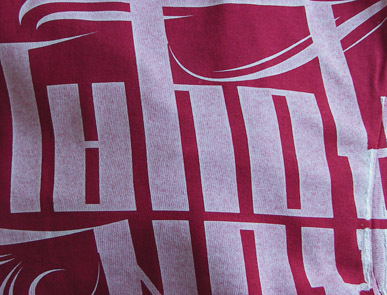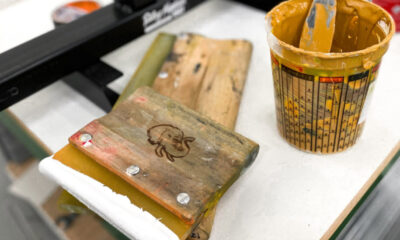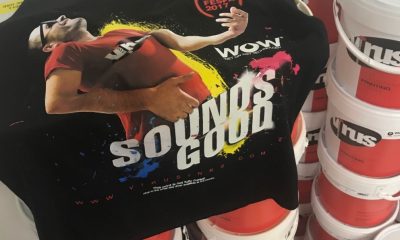Inks & Coatings
Published
17 years agoon

A lot of printers are now discovering discharge inks and printing. Those of us who have been at this for more than a few years have to chuckle just a little about this so-called discovery. Discharge textile inks have been around for a long time and have gone through cycles of popularity just like a lot of other screen-printing inks. Discharge inks are experiencing what I would have to call a renaissance.
A lot of printers are now discovering discharge inks and printing. Those of us who have been at this for more than a few years have to chuckle just a little about this so-called discovery. Discharge textile inks have been around for a long time and have gone through cycles of popularity just like a lot of other screen-printing inks. Discharge inks are experiencing what I would have to call a renaissance.
Sales of discharge inks are greater right now than they’ve been since the early 1990s. Back then, their popularity was fueled by the use of belt printers. Belt printers required the use of waterbased inks; therefore, the only way to use a belt press to print on dark fabric was to use discharge inks. When belt printing fell out of favor, discharge seemed to follow it down rather rapidly.
But discharge inks never went away. In fact, they just got better and more versatile. In addition, the garment manufacturers have become much more supportive of discharge printing through their use of discharge-friendly dyestuffs (more on that later). Discharge inks come in a wide array of types, including some that are actually combined with plastisol, which is used as the source of the replacement color.
How discharge works
Discharge inks work by extracting or bleaching out the dye from the fabric being printed. Some formulations replace the dye with the pigment (color) in the ink that is printed (Figure 1). The process seems a little magical to those who have never seen it, because discharge is a steaming process that actually takes place in the dryer. The print does not look very good when the fabric/garment is removed from the print platen, but it looks great after it’s properly cured (Figure 2). Additionally, discharge prints are among the most demonstrative of a complete cure. If the appearance after curing is right, the garment is most likely fully cured.
Discharge inks require an activator/catalyst to work. There are two different systems available, one of which is much more prevalent than the other. The predominant system relies on zinc-formaldehyde-sulfoxylate (ZFS) as its active ingredient. The newer, and less common, system relies on thiourea dioxide as its active ingredient. In both systems, the ink has a limited pot life once the activator is added. Most ink manufacturers cite a pot life of six to eight hours. My preference and recommendation is to work with activated quantities of what will last two to four hours in order to always keep the ink fresh.
Discharge requires a dryer that can extract, or steam off, all of the water in the time that it takes the fabric to pass through the chamber. True water-based discharge involves a lot more water to get rid of than the plastisol/water-based hybrid systems. For this reason, companies with smaller or less capable dryers are usually better off trying the hybrid systems first. Then, as their experience evel increases, and if they get a more powerful dryer, they can move to the pure water-base discharge products— if they really want to.
Water-based ZFSactivated discharge
Water-based ZFS-activated discharge is the most traditional and still the most versatile method of discharge printing. The availability of colors, the consistency of the prints, and the softness of the resulting finish are superior to other discharge systems. There is virtually no hand to the print, even on black fabric.
Printers can add pigment concentrates to the discharge base at any time, and the pigment-base combinations poses no pot-life constraints. The only time that the clock comes into play is when the discharge agent (ZFS) is added to the ink. Never take this step until you are ready to print.
A direct correlation exists in all discharge systems between the amount of discharge agent used and the initial feel or hand of the fabric after printing. Too much discharge agent causes the finished print to have a harsher or heavier feel than a print done with the minimum amount of discharge agent. In addition, extensive testing has found no advantage to using a higher level of discharge agent than the minimum recommended amount for a given ink system. So, if a manufacturer’s instructions call for 6-9% discharge agent, the use of 6% will give the best results. Washing the garment for the first time after printing removes any harshness caused by the discharge agent and delivers the ultimate fabric softness.
Plastisol/water-basedhybrid discharge
Hybrid discharge inks have been around for more than 10 years. However, the major growth in their use has only occurred in the past two years. It is my opinion that the ease of using these inks is a major factor in fueling the present discharge craze. The most important advantage of plastisol/water-based-hybrid discharge inks is that they are much easier to use for those that have never used discharge or water-based ink systems.
Even though the ink is 50% water-based, the tendency to dry in the screen is much less than with 100% water-based products. In fact, the plastisol tends to have a retarding effect on the ink in the screen. Printers who use hybrid discharge inks are able to use a plastisolprinting procedure of having the screen unflooded between prints. A true waterbased procedure requires printers to keep the screen flooded between prints. And even when there is a break in the printing, where the screen starts to dry in, the effect usually can be reversed by the simple use of a double stroked squeegee in the discharge screen. Keeping the screen flooded between prints is still a better procedure. It helps to keep the screen ready for a proper print each time without the need for an extra cycle.
Water-based thioureadioxide-activated discharge
Thiourea-dioxide-activated discharge inks were developed to address the issue of formaldehyde exposure and residue associated with ZFS-activated discharge inks. They work in a similar fashion and with similar pot-life parameters. These products are still quite new to the textilescreen-printing market. I’ve heard from many printers who have tried them and reported having issues with color intensity in certain shades.
Thiourea itself also warrants consideration. This chemical compound has some very unique handling and shipping requirements. It is considered to be a spontaneously combustible product. While the actual use of this product is not as dangerous as that expression may sound, there are some definite handling requirements, and it cannot be shipped without hazard packaging via UPS and Federal Express. I do not think that these challenges are impossible to overcome and believe that these products will be made easier to use and transport in the future.
Methods of using discharge
There are two distinct methods of discharge printing, both of which can be used regardless of discharge system. The traditional method is to discharge every color in the print. By discharging all colors, there is no need for an underbase screen. This technique saves a screen and does away with the need for any flashing between colors. The exception to this all-color rule is when a black-ink screen is needed. There’s no need to use discharge if the black will cover without it. If the fabric is black, any black that is part of the design can be reversed out to use the shirt color itself.
The second method is to use discharge strictly as an underbase. With this method, you can use either white discharge or natural discharge, which contains no pigment of its own and reveals the ground color of the fabric. Then, with or without flashing, the subsequent colors are printed with regular plastisol. I prefer to not flash the discharge underbase. This method saves not only the head used for the flash, but also any cooldown heads. The result is that printers can increase the number of colors they can print on dark shirts by at least one, possibly two.
The white discharge underbase works extremely well for most design types, especially spot-color work. Even though the other colors are printed using plastisol, the overall print has a less heavy feel because the underbase is basically a water-based product. If a design contains halftones or other areas with very thin ink deposits, then a natural discharge underbase may work much better. The white pigment in the white discharge underbase may mix with subsequent thin ink deposits and shift their color. But this is usually not an issue with spot colors.
Discharge underbasing also makes true process printing on dark fabrics possible. For process printing, again, do not use a white discharge underbase. If the white pigment mixes with the transparent process inks, they will turn very pastel. Instead, work with a natural discharge underbase that will reveal the natural cotton background color. Major ink companies have triple-strength versions of their process-ink systems to compensate for the less than perfect background—these 3X inks overcome the off-white background color. The one kicker is that if the design contains any white color of its own, you’ll need to print a white highlight as part of the process design. Ink companies also provide a special white highlight ink that is designed to print with the process inks in this application.
Product costs
Discharge printing is typically very cost effective from the standpoint of the initial product cost and per print cost. The increased production speeds compared to a strictly plastisol print on dark fabric makes these savings possible. Waste can be an issue should you activate too much ink for a particular job. However, you can minimize the amount of waste through proper shop procedures, ink estimating, and using expired ink on light fabrics (more on this later).
Safety issues in production
Screen printing involves chemicals. Some are safer than others. The chemicals involved in discharge printing must be used properly to be safe. The names of the activators even sound a little on the dangerous side: zinc-formaldehydesulfoxylate and thiourea dioxide. Both of these chemicals have their handling, environmental, and residual issues. Those who plan to use either system are advised to understand the chemicals and train their staffs to properly handle and use them in production.
ZFS has the rather unpleasant odor of formaldehyde and rotten eggs. It should be handled carefully in its crystalline form and blended into the ink by an employee who is properly trained in its use. Remember to blend the ZFS slowly until it is in solution to prevent the dust from becoming airborne. ZFS is relatively safe once in solution, but it still should be kept from contacting skin. Formaldehyde is a skin irritant.
ZFS discharge is safer on press. It won’t evaporate quickly, and very little ZFS can become airborne at this level. Proper procedure is most important during the curing stage. Dryers used for discharge curing should be properly vented. Unvented dryers should never be used for discharge curing.
Thiourea dioxide also should be handled carefully. It is a strong oxidizer and must be kept in a sealed container. All of the same precautions that are recommended for ZFS are also applicable to thiourea dioxide.
Both products are strong oxidizers and should be kept in sealed containers. When pouring the crystalline powder into the mixing container, efforts should be made to minimize dust. Neither product generates measurable volatile organic compounds, and no special reporting of use is required. Occasional direct contact exposure is not considered an immediate health threat.
Waste (leftover) discharge ink
Waste discharge ink, like all inks in a liquid state, is considered a hazardous waste. But even though it will no longer discharge after the pot life has expired, you can still use the ink to produce soft prints on light or white fabrics. An ink that would print a nice red on black fabric will give you the exact same color on white fabric. Many print runs have the same print on light and dark fabrics. In these cases, always print the darks first and then use the time-expired discharge inks on the lights. This workflow minimizes waste and improves cost control.
Post production
Garments printed with ZFS discharge have measurable levels of formaldehyde. Washing the garment removes all traces of the chemical. Garments that are allowed to sit for a time after printing in an unconfined state will outgas most of the formaldehyde within a few days. If at all possible, avoid folding and packing ZFS-discharged garments immediately after printing.
The best recommendation I can make is to let the end consumer know, through the use of a sticker or hang tag, that the garment should be washed before wearing. In my shop, we used a sticker that explained the wonders of the unique printing process and advised buyers to wash the fabric before wearing—all in one breath.
The European Union has a formaldehyde-exposure threshold of 75 ppm for apparel for small children and infants. A ZFS-discharged garment that has not been aired out for several days or washed after printing will not pass this test.
Recommendations
Discharge printing can be a valuable addition to your operation. It can improve productivity and print quality on dark fabrics, help increase the number of colors you can print, and produce extremely soft prints.
Discharge is not a panacea. It is not a turnkey use-it-and-forget-it product. Discharge printing comes with safety precautions, issues with finished goods, and considerations for shop health. None of these issues is that difficult to deal with, but none can be ignored. If you’re not prepared to properly handle the discharge products, don’t even try them. But if you’re ready to make the effort, you’ll be pleasantly surprised with the result. n
Mike Ukena is a 15-year screen-printing veteran who has owned a textile-printing company and worked in technical services for the Specialty Graphic Imaging Association Int’l as the director of education. A member of the Academy of Screen Printing Technology, Ukena is a frequent speaker on technical and management topics at industry events. He is currently a technical sales representative for Union Ink Co., Inc.

Subscribe

Magazine
Get the most important news
and business ideas from Screenprinting Magazine.
Most Popular
-

 Case Studies2 months ago
Case Studies2 months agoHigh-Density Inks Help Specialty Printing Take Center Stage
-

 Art, Ad, or Alchemy2 months ago
Art, Ad, or Alchemy2 months agoF&I Printing Is Everywhere!
-

 Andy MacDougall2 months ago
Andy MacDougall2 months agoFunctional and Industrial Printing is EVERYWHERE!
-

 Columns3 weeks ago
Columns3 weeks ago8 Marketing Mistakes Not to Make When Promoting Your Screen Printing Services Online
-

 Editor's Note3 weeks ago
Editor's Note3 weeks agoLivin’ the High Life
-

 Marshall Atkinson3 weeks ago
Marshall Atkinson3 weeks agoHow to Create a Winning Culture in Your Screen-Printing Business
-

 Thomas Trimingham2 months ago
Thomas Trimingham2 months ago“Magic” Marketing for Screen Printing Shops
-

 News & Trends2 months ago
News & Trends2 months agoWhat Are ZALPHAS and How Can You Serve Them in Your Print Business?





